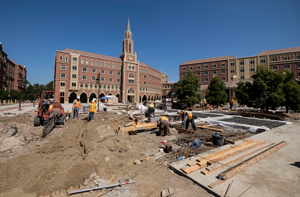
By the time USC students hit the books in the fall, 2,700 of them will be taking up residence in new dorms at USC Village, a cluster of collegiate Gothic buildings set on 15 acres north of campus.
The $700 million project, the university’s single largest such venture in its 137 years, might encourage developers to take a second look at surrounding neighborhoods that have long been neglected, local real estate professionals said, despite the challenge of assembling development sites in a dense area.
“Any development of this magnitude gets people’s attention,” said Jamie Brooks, a CBRE vice president. “This is a neighborhood that since 1992 was historically ignored. It ultimately will drive more jobs, more housing, and more retail.”
USC Village is replacing University Village, an outdoor shopping center built on the site of a former meatpacking plant at Hoover Street and Jefferson Boulevard, according to USC’s Master Planning website. Demand for new student housing drove the university’s decision to tear it down.
“We have more students living within a one-mile range of campus than ever before,” said Laurie Stone, USC’s associate senior vice president for real estate and asset management. “It has changed dramatically, to where it’s much more of students coming from not only Southern California but also from all around the state, from the United States, and internationally.”
Funding for USC Village derived mostly from donations and the university did not use construction loans, Stone said. Since launching an aggressive fundraising campaign in 2011, USC has raised nearly $6 billion and is allocating $1 billion for development.
USC Village will boost the university’s bed tally to nearly 10,000 from 7,000. The school enrolled 19,000 undergraduate and 25,000 graduate students in the 2016-17 academic year.
The project’s 134,000-square-foot retail component will be anchored by Trader Joe’s and Target. Other tenants are slated to include eateries Trejo’s Tacos, Cava Grill, and Rance’s Chicago Pizza, shoe repair shop Village Cobbler, Sole Bicycles, Bank of America, and Starbucks.
“We tried to make it something that would be interesting and enticing to a broad range of people – USC community and neighborhood community, all in one,” Stone said.
She would not disclose asking rents, but Derrick Moore, a principal at Avison-Young and the leasing broker for Canfield Development Inc.’s Element apartment and retail complex nearby on Hoover, said monthly retail rates in the area range from $3.50 to $4.50 a square foot, although USC Village’s rates would be higher. He also noted that some businesses that could not pin down USC Village leases are looking at Element, which caters to students.
The project is part of an ongoing redevelopment at USC, which also plans to demolish three student housing complexes on about 12 acres that it owns west of USC Village, Stone said, for the construction of up to 2,200 beds. The school holds entitlements to build retail, hotel, and academic space there.
The Los Angeles Memorial Coliseum is targeted for a major renovation as well after the multiagency Coliseum Commission last week approved a $270 million project funded by USC. The facelift still needs City Council approval and is slated for completion in August 2019.
Private developers are already moving in as well, including apartments, hotels, and retail projects all in various stages of development within blocks of the campus.
Businesses on the blocks surrounding USC Village appear optimistic about their new neighbor.
“It’s a great improvement, putting a major development in this neighborhood so there’s more jobs and safety,” said Saabi Singh, owner of 23rd Street Café, an Indian-Mexican fusion eatery that sits alongside historic Victorian-style homes.
Sean Keklikyan, owner of Village Cobbler, said he plans to move into USC Village in the next couple of months, returning his business to the location where it had been since the 1980s. His revenues fell 40 percent since moving out in 2014 to make way for construction.
“It’s two blocks away, but it’s going to be very different,” he said. “Maybe after a couple of years it will be better here (on Hoover), too.”
At Aries Hair Design & Barber Shop nearby on Union Avenue, hairdresser Vanessa Gomez said the development would bring pros and cons to the area where she’s lived for more than a decade. The university has helped make the streets safer in recent years, and the people living and shopping at USC Village could bring her more business.
Apartment rents have already been skyrocketing and that’s hard for minimum-wage families to absorb, she said.
That has led some South L.A. community advocates to push for projects to meet the needs of USC students as well as local low-income families – while acknowledging that this balancing act is tricky.
“It’s a double-edged sword,” said Robin Hughes, president of affordable housing developer Abode Communities, which is replacing a 48-unit multifamily property near Exposition Boulevard and Vermont Avenue with 140 affordable housing units.
“The development will bring much needed space for the university. … That will definitely help to support the local economy, bring about jobs, take a little bit of pressure off the housing market. But at the same time, it will continue to impact gentrification with folks not being able to remain in the neighborhood as rent prices go up and land costs go up.”
Editor’s Note: This story has been updated to correct the architectural style described for USC Village.
